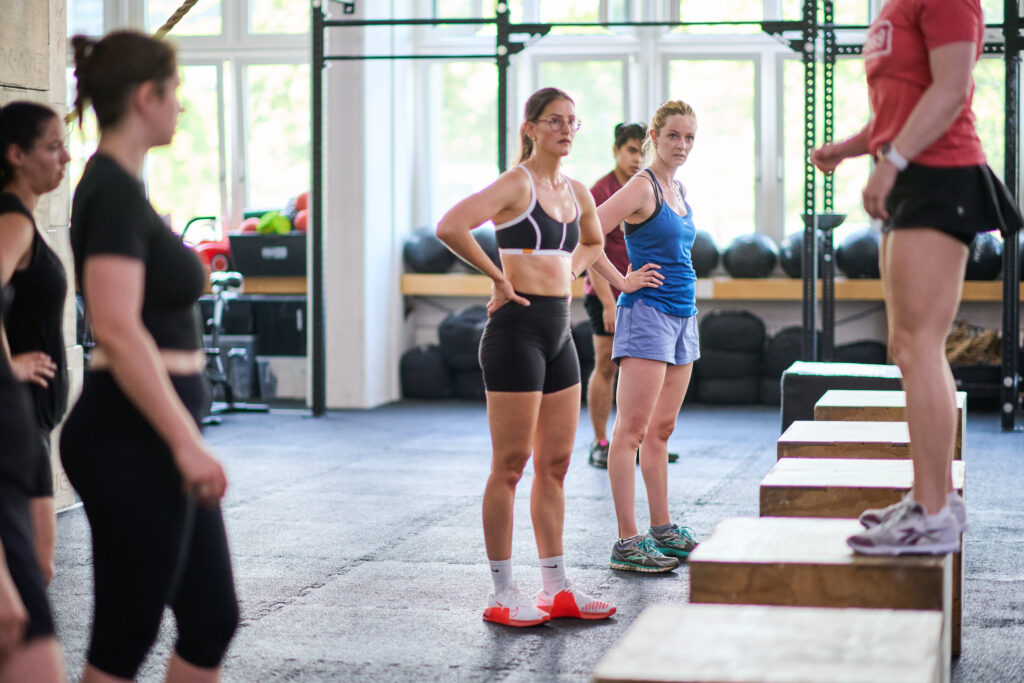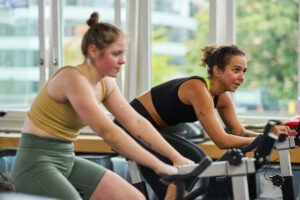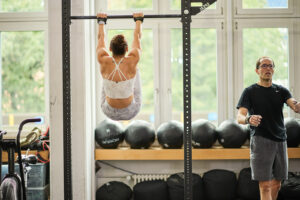
Training vs. testing
In CrossFit, intensity is expected. It’s built into the DNA of the methodology—and it’s part of what makes it so effective. But there’s a difference between high intensity and maximum intensity. And there’s a big difference between training for progress and testing for performance.
Intensity, in any fitness context, feels hard. But in CrossFit, it often feels like you can’t breathe. That’s by design—working at high intensity (doing more work in less time) is what drives results. But chasing maximum effort every day is not the goal. There’s a fine line between training smart and just surviving a workout.
Too often, athletes blur the line between showing up to train and showing up to prove something. And while both can feel similar in the moment—sweaty, hard, demanding—they produce very different results over time.
Let’s unpack why knowing the difference could be the key to your next big breakthrough.
What is training?
Training is a long game. It’s about building your capacity over time through thoughtful, consistent, and progressive effort. In a training session, you’re deliberately working to provoke adaptations—strength, skill, endurance, coordination—not just trying to survive a workout or post a score.
Training means doing the hard, sometimes boring stuff that doesn’t earn you a round of applause. It’s perfecting your positions. It’s accumulating volume. It’s doing sets of gymnastics instead of singles—even though it’s slower. It’s sticking to tempo, rest periods, and movement standards. It’s sacrificing the fastest time for the best progress.
What is testing?
Testing is the opposite: it’s about expressing your current ability, not expanding it. It’s where you go all out. You see what you’re capable of under pressure. Testing tells you where you are. Training gets you where you want to be.
Think of it like school: training is studying; testing is the exam. You wouldn’t take an exam every day and expect to learn. So why treat every workout like a competition?
CrossFit: where intensity is the norm
Because CrossFit is built on intensity, it’s easy to get caught up in maximum effort every day. And let’s be honest—it feels good. There’s a high in pushing to your limits, beating your old score, or finishing first.
But intensity without intent is just noise.
High intensity means working hard enough to stimulate adaptation. That doesn’t mean working as hard as humanly possible all the time. True training requires controlled intensity—choosing to do three reps unbroken instead of one rep and a rest, even if that’s slower today. The fastest time might be single reps with short breaks, but the best trainingstimulus comes from manageable sets and smart pacing.
You will need to sacrifice the best time for the best progress. That’s not weakness—it’s wisdom.
The testing trap
The problem with always chasing the leaderboard is that it turns training into performance. You begin to:
- Skip progressions that would build better movement
- Scale less intelligently to protect your ego
- Ignore mechanics in favor of speed or weight
- Avoid workouts that don’t play to your strengths
Soon, every day becomes a performance. But performances aren’t where you grow. They’re where you show what you’ve grown.
Training vs. testing: How you approach the workout matters
The same workout can be done two ways: to test your limits or to expand them.
Take Fran (21-15-9 thrusters and pull-ups). If today’s goal is to test, maybe you go for broke—fast singles on pull-ups, short rest, try to beat your last time.
But if you’re training, you might approach it differently. Maybe you scale the pull-ups to a challenging number you can sustain in sets. Maybe you use a thruster weight that allows you to keep perfect form under fatigue. You might rest longer between rounds to maintain movement quality.
Both versions are intense. But only one is truly helping you get better right now.
Are you working out or showing off?
If you:
- Avoid scaling even when it would help you improve
- Choose movements for how they look, not how they help
- Go all out every session but feel stuck in your progress
- Judge a session by how dead you feel instead of how much better you got
…you might be testing more than you’re training.
And here’s the twist: the people who seem to progress the most often train the least impressively. They move well. They rest when needed. They scale smart. They do boring accessory work. They stick to the plan. And when it’s time to go hard, they can—because they’ve built the foundation.
How to train like a pro (even if you’re not one)
- Know the goal of the session
Is today about building strength? Dial in your rest, keep your technique crisp. Is it aerobic conditioning? Stay consistent, not frantic. Don’t confuse intensity with chaos. - Make intentional scaling decisions
Scaling doesn’t mean making it easy. It means making it effective. Sometimes that means doing sets, not singles—even if it means a slower score. - Respect the difference between showing up and showing off
You don’t need to win the workout. You need to win the week, the month, the year. Aim for longevity and long-term results. - Log your sessions beyond scores
Write down how it felt. What you learned. What you could improve. Not just the weight or time. That’s where the gold is.
The quiet path to real progress
The best training sessions often go unnoticed. There’s no PR. No leaderboard win. Just solid effort, done with intention. In the competition training vs. testing, training should win.
But string together enough of those days, and your next test will surprise you.
Not because you tried to impress someone—but because you trained when no one was watching.
Train with purpose. Test with intent. And don’t just work out—work to get better.




